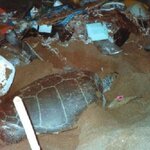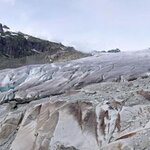Oceanography

Pioneering new research sheds light on the impact of climate change on subglacial lakes found under the Greenland ice sheet.
A team of experts, led by Dr Steven Palmer from the University of Exeter, has studied the water flow paths from one such subglacial lake, which drained beneath the ice sheet in 2011.
The study shows, for the first time, how water drained from the lake - via a subglacial tunnel. Significantly, the authors present satellite observations that show that a similar event happened in 1995, suggesting that this lake fills and drains periodically.
The study, called Subglacial…

A new global review led by the University of Exeter that set out to investigate the hazards of marine plastic pollution has warned that all seven species of marine turtles can ingest or become entangled in the discarded debris that currently litters the oceans.
The research, which was carried out in collaboration with Plymouth Marine Laboratory, North Carolina Wildlife Resources Commission, North Carolina State University, Duke University Marine Lab and James Cook University, is published in the ICES Journal of Marine Science and reveals serious knowledge gaps in the diverse and complex…

A pilot Earth Index commissioned by BBC Earth using data from the United Nations Environment Programme World Conservation Monitoring Centre (UNEP-WCMC) sets a new standard for estimating pretend money. It values coral at $10 trillion for the global economy. Trees are worth even more, at $16 trillion, which means the pretend value of trees are almost as much as all of the real value of the people in the United States (GDP $17.42 trillion.) Heck, the Grand Canyon is worth $700 million and it just sits there looking stoic.
Obviously "virtual" has to be taken with a grain of salt. "Virtual water…

If you've ever waited on an airport runway for your plane to be de-iced, had to remove all your food so the freezer could defrost, or arrived late to work because you had to scrape the sheet of ice off your car windshield, you know that ice can cause major headaches.
Previous research by other groups has focused mainly on the frost-preventing properties of superhydrophobic (ultra water-repelling) surfaces. In general, the surfaces work by repelling water droplets before they have time to freeze.
There is little research, however, on surfaces that mix hydrophobic and hydrophilic areas…

Researchers from the University of Exeter believe they have solved one of the biggest puzzles in climate science. The new study, published in Nature Geoscience, explains the synchrony observed during glacial periods when low temperatures in the Southern Ocean correspond with low levels of atmospheric carbon dioxide (CO2).
The interdisciplinary study, carried out in collaboration with the University of Tasmania, demonstrates how a reconfiguration of ocean circulation can result in more carbon being stored in the deep ocean that previously thought.
The researchers used a computer model…

The high frequency and magnitude of volcanic eruptions could have been the cause of the progressive cooling of ocean surfaces over a period of 1,800 years, according to a new study.
The study emphasizes that this trend came to an end with the beginning of the Industrial Revolution and the resulting global warming caused by human activity. It further shows that the lowest temperatures in the first 1,800 years of the Common Era were recorded between the 16th and the 18th centuries, a period known as the "Little Ice Age".
Earlier research had already shown that volcanic explosions cause the…

As you all know, the ecosystem is like a giant human anti-lung - it breathes in the CO2 we exhale and helps produce oxygen.
It turns out that the Southern Ocean seasonally absorbs significantly more CO2 than they release, higher than previous estimates. Most importantly, these seas remove a large part of the CO2 that human activities emit into the atmosphere, thereby slowing down the growth of this greenhouse gas in the atmosphere, which has been lessening the rate of climate change.
That doesn't mean pollution can remain unchecked, the Southern Ocean is only 25 percent of the total surface…

Researchers from CSIRO and Imperial College London have assessed how widespread the threat of plastic is for the world's seabirds, including albatrosses, shearwaters and penguins, and found the majority of seabird species have plastic in their gut.
The study, led by Dr Chris Wilcox with co-authors Dr Denise Hardesty and Dr Erik van Sebille and published today in the journal PNAS, found that nearly 60 per cent of all seabird species have plastic in their gut.
Based on analysis of published studies since the early 1960s, the researchers found that plastic is increasingly common in seabird's…

The World Glacier Monitoring Service, which compiles the results of worldwide glacier observations in annual calls-for-data, has compiled such data on glacier changes for more than 120 years.
Now they have published a new analysis of global glacier changes and say observations of the first decade of the 21st century (2001-2010) compared to all available earlier data from in-situ, air-borne, and satellite-borne observations as well as to reconstructions from pictorial and written sources leads them to believe that observed glaciers currently lose between half a meter and one meter of ice…

There’s a new study that’s getting a fair amount of attention in the climate science community and the popular press.
Published online in Atmospheric Chemistry and Physics, the paper argues that melting from Greenland and Antarctica will occur faster than previous projections, leading to rapid sea level rise of several meters, potentially this century. It looks at the prehistoric record to conclude that ice sheets are vulnerable to “non-linear” disintegration, or rapid melting from higher temperatures. It builds on a study published last year that found that melting in West Antarctica was…